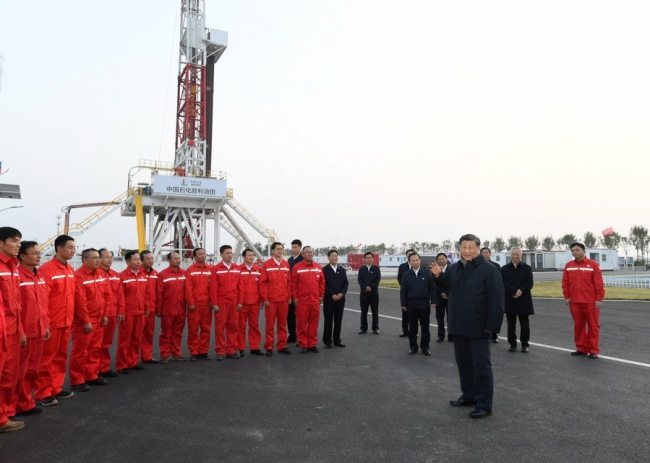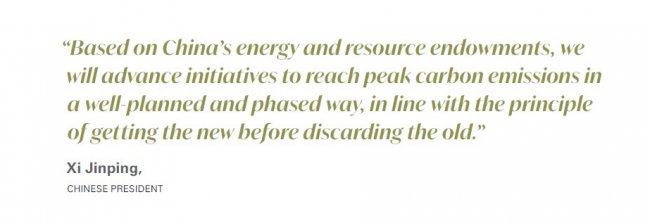Chinese CCS picks up pace [Gas in Transition]
China’s traditional energy and industrial heavyweights are spearheading the country’s early development of carbon capture, utilisation and storage (CCUS) projects, as Beijing leans on these deep-pocketed major emitters to prove out the technology and its economics for wider adoption in their respective sectors.
CCUS in China is gaining traction after a slow start, supported by more climate-focused policies and guidance from the central government since president Xi Jinping committed Beijing two years ago to peaking carbon emissions before 2030 and then zeroing them out before 2060.
Most studies indicate CCUS will be essential to achieving the two long-term goals. China will need to scale up its CCUS capacity by more than 400 times in the next four decades to 1.3 gigatons/year of CO₂ by 2060, as a shift to cleaner energy sources and improved energy efficiency will not be enough to reach net-zero, according to Shell.
While this is technically possible, as many of the CCUS technologies in China are close to or have reached commercialisation, the main challenge lies in creating conditions to support substantial investment in large-scale CCUS – particularly as a solution to industrial decarbonisation.
NOCs lead the charge
Growing momentum for CCUS was underlined by its inclusion last year in China’s 14th Five-Year Plan (FYP) for the first time, with calls for more implementation of demonstration projects that experts tell NGW should lay a solid foundation to foster Chinese development.
The pace of pilot projects has picked up recently among China’s oil and gas majors, which are seen as best-placed to lead large-scale CCUS development as they have the deep pockets and natural resource endowments necessary to build such facilities.
A significant share of the majors’ emissions comes from natural gas processing, coal-to-chemicals, and ammonia production. These processes are mainly located in Xinjiang and Inner Mongolia, and near depleted oil and gas fields and saline aquifers that can be used as carbon sinks to minimise CO₂ transportation costs.
State-owned Sinopec, China’s largest refiner, brought its first megaton-class CCUS project online at the mature Shengli oilfield in the eastern province of Shandong in late August. The facility will be able to sequester 1mn metric tons/year of CO₂ – equivalent to the annual emissions of nearly 600,000 economy cars.
Sinopec’s Qilu refinery will capture high-concentration CO₂, which will then be transported 80 km to the Shengli oilfield and injected 3-4 km underground for enhanced oil recovery (EOR). Most CCUS projects in China are used for EOR and Sinopec’s facility is expected to yield an additional 2.965mn mt of crude oil over the next 15 years.
Sinopec aims to build another two pilot projects over the next few years in the nearby Huadong and Jiangsu oilfields. Last year, Sinopec captured 1.52mn mt of CO2 and utilised 308,000 mt of it for EOR, increasing oil output by 89,000 mt.. The company is looking into the possibility of combining CCUS with renewables, hydrogen and biomass energy to spur technological innovation and build on its early success in the CCUS space.
Fellow NOC PetroChina meanwhile announced in March it had started building a demonstration project in the Songliao oilfield with a designed capacity of 3mn mt/yr. This forms an early part of the major’s efforts to lift CCUS capacity for internal use to 3.7mn mt/yr by 2025, 25mn mt/yr by 2035, and then 100mn mt/yr by 2050.
 PetroChina expects CCUS to play a key role in helping it meet carbon intensity targets for 2025, which it recently upgraded to 17 kg/barrel of oil equivalent from an original target of 20-21 kg/boe. The company also plans to sell CCS services to other companies, with an aim to make 100mn mt/yr of capacity available to the market by 2035.
PetroChina expects CCUS to play a key role in helping it meet carbon intensity targets for 2025, which it recently upgraded to 17 kg/barrel of oil equivalent from an original target of 20-21 kg/boe. The company also plans to sell CCS services to other companies, with an aim to make 100mn mt/yr of capacity available to the market by 2035.
Offshore-focused Cnooc is also exploring CCUS as it looks for further ways to apply its marine technical capabilities. Cnooc signed a memorandum of understanding with Shell and ExxonMobil this summer to study the development of a world-scale offshore CCS hub in the southern province of Guangdong that could capture 10mn mt/yr of CO2.
The agreement came days after the NOC launched China’s first offshore CCS demonstration project to serve the Enping 15- 1 oilfield in the South China Sea – up to 1.46mn mt of emitted CO2 during the oil extraction process will be sequestered in undersea reservoirs over the lifetime of the field.
Although Cnooc has not provided specific targets for CCUS, the demonstration project is likely to be extended to the Enping 10-2, 15-2 and 20-4 oilfields in the next few years, enabling emission reductions as well as EOR for the oilfields to achieve higher economic returns.
Most of the domestic oil and gas fields owned by China’s NOCs are in their early-to-middle stage of construction or operation, and it will not be possible to halt production at these upstream assets in the near term. CCUS therefore represents an ideal way to decarbonise them to keep them in play while China transitions to a low-carbon economy.
This dovetails with Beijing’s evolving stance on decarbonisation, which now appears to be that climate goals will not come at the expense of economic growth or energy security. “Based on China’s energy and resource endowments, we will advance initiatives to reach peak carbon emissions in a well-planned and phased way, in line with the principle of getting the new before discarding the old,” Chinese President Xi Jinping said in mid-October at the Communist Party’s 20th national congress in Beijing.
CCUS debuts in steel, coal sectors
Besides oil and gas, Chinese steelmaking is also expected to see more CCUS projects deployed after its first large-scale commercial pilot. Baotou Iron and Steel Group recently started building its CCUS pilot, a key part of its abatement strategy to achieve net zero by 2050. With post-combustion chemical absorption, the project will capture off-gases from three Maerz lime kilns and hot blast stoves.
Construction is split into three phases, starting with 500,000 mt/yr of CO2. The next two stages will add 500,000 mt/yr and 1mn mt/yr of capacity respectively. The pilot will also test steel slag utilisation and low-carbon logistics.
Under the first phase some 450,000 mt/yr of CO2 will be liquefied and transported by electric trucks running on swappable batteries to nearby oilfields for EOR. The remaining 50,000 mt/yr will be transmitted by pipeline to a first-of-its-kind mineralisation pilot to make use of 100,000 mt of slag. The reaction between the CO2 and slag will make calcium carbonate, which is used in everything from paper and plastics to building materials.
Baotou has also proposed purifying some of the 450,000 mt/yr, so that it can be used by the food industry.
CCUS is a necessary technological hedge to reduce emissions from heavy industries like steelmaking. As 90% of China’s steel is produced from blast furnaces, domestic steelmakers like Baotou will likely use more CCUS to cut emissions.
China’s coal power fleet – the largest in the world with 1,140 GW of installed capacity forecast by the end of this year – is also embracing CCUS. China Huaneng Group, one of the country’s five state-owned major power utilities, recently announced the world’s biggest CCUS project for coal power plants, which will be 10 times the size of the largest existing coal power-based CCUS project in China.
Located in Gansu province, it will capture 1.5mn mt/yr of CO2 from two 1-GW coal power plants once it is commissioned by the end of next year. More than 90% of the emissions will be captured for EOR and storage.
China’s coal capacity is expected to reach 1,250 GW by 2025. Large-scale CCUS is therefore key for decarbonisation, as the country plans to rely on coal power in the long run for flexible services amid more production of intermittent renewable energy.
The success of these projects and others is crucial as it would encourage more companies in various sectors to opt for CCUS as a viable solution to achieve their long-term decarbonisation goals. Carbon pricing will be an important factor in CCUS activity going forward, with the price of allowances in China still low at less than $9 in mid-October but likely to see a rise in the coming years with stricter free allowances and dedicated public regulations.
Policy development accelerates
China’s central government mentioned large-scale CCUS demonstration projects for the first time in its 14th FYP, an outline of which was published at the annual parliamentary session in March 2021. This was followed by an announcement of support by the Ministry of Ecology and Environment and several other ministries for pilot and demonstration projects in free trade zones.
CCUS was included in the China-US Joint Statement Addressing the Climate Crisis, issued in April 2021 between US president Joe Biden and Xi. Then in June 2021, China’s top economic planning agency issued a notice to request CCUS project information, with the aim of supporting major projects in the near future.
A CCUS roadmap released by the Chinese government in 2019 called for China to seal 9mn mt/yr of CO₂ underground by 2025, rising to more than 20mn mt/yr by 2030, 70mn mt/yr by 2035, 200mn mt/yr by 2040, and 800mn t/yr by 2050.



